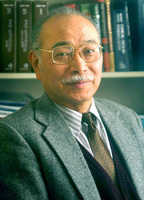 Toshimichi Shinohara, Ph.D., admits he didn’t know much about Nebraska, much less the University of Nebraska Medical Center, when a colleague mentioned that he may want to explore possibilities in Omaha.
Toshimichi Shinohara, Ph.D., admits he didn’t know much about Nebraska, much less the University of Nebraska Medical Center, when a colleague mentioned that he may want to explore possibilities in Omaha.
A couple of months into his role as a researcher and professor in the department of ophthalmology, Dr. Shinohara is excited about the next decade’s promise for his research at UNMC.
“I see an opportunity, over the next 10 years, to develop a significant amount of research here,” said Dr. Shinohara, most recently a faculty member at Harvard University. “With the quality of sciences that we have here, we can get the money from the National Institutes of Health that we need to become a premier research center.”
A longtime researcher at the National Eye Institute, Dr. Shinohara is an internationally known expert in the molecular basis of disorders of the retina and lens. He has authored nearly 140 scientific publications and presented more than 200 abstracts. He and his associates will bring to UNMC research funding from the NIH and other organizations.
“Dr. Shinohara brings a new and exciting dimension to ongoing research at UNMC into the identification and treatment of degenerative diseases of the eye,” said Carl Camras, M.D., a prolific researcher and chairman of the department of ophthalmology at UNMC. “We’re excited about the potential of research in this area, and we think that Dr. Shinohara’s expertise and reputation will enhance our reputation and fortify our position among leading ophthalmology centers.”
|
|
Research collaborations
Dr. Shinohara already has initiated a collaboration with Marjorie Lou, Ph.D., a professor in veterinary and biomedical sciences at the University of Nebraska-Lincoln. Dr. Lou’s research has focused on the mechanism of cataract formation.
“Science does not have boundaries, and speedy progress comes from collaborations,” Dr. Shinohara said.
Recruiting the best
Dr. Shinohara is among the first faculty members recruited through the tobacco settlement funds that the Nebraska Legislature allocated to the state’s four biomedical research institutions — UNMC, the University of Nebraska-Lincoln, Creighton University and Boys Town National Research Hospital.
In 2001-2002, the Legislature allocated nearly $5 million to the UNMC Tobacco Settlement Biomedical Research Development Fund. Already, funds have been used to recruit Dr. Shinohara, William Rizzo, M.D., a pediatrician who heads the Munroe-Meyer Institute’s biochemical genetics department; George Hemstreet, M.D., Ph.D., chairman of the section of urology in the College of Medicine; and Gloria Borgstahl, Ph.D., one of the world’s only x-ray crystallographers with the background and ability to solve problems relevant to the interaction of cancer cells with anti-cancer agents.
“The ability of UNMC to recruit outstanding scientists like these is a tribute to our growing reputation as a major research center,” said Thomas Rosenquist, Ph.D., vice chancellor for research at UNMC. “The support provided by Governor Johanns and the Nebraska Legislature, via the tobacco settlement fund, is crucial to the recruitment process.”
Reducing cataract frequency
One of Dr. Shinohara’s research focuses is on isolating survival factors for lens epithelial cells (LECs). These cells are involved in maintaining the physiology of the lens, including transparency. One avenue of Dr. Shinohara’s research led to his discovery of a survival factor, lens epithelial-derived growth factor, which has promise in keeping the formation of LECs constant in older adults. Harnessing this survival factor would be a key to staving off cataract formation in older adults, because LECs are involved in maintaining the physiology of the lens, including transparency.
“Cataracts are a major cause of visual impairment in the world, with more than 60 percent of the population suffering from disorders related to them at some point,” Dr. Shinohara said. “The discovery of this survival factor, and the ensuing research into that factor and its relationship to the lens epithelial cells, is a very exciting and promising avenue toward reducing cataract frequency.”
Living in the Heartland
In addition to the research possibilities that UNMC provides, Dr. Shinohara also said that he is enjoying his first taste of living in the Heartland.
“In five minutes, you can get to anything. There’s a variety of ethnic stores, and restaurants that you can go to,” he said. “The quality of life is much better here.”